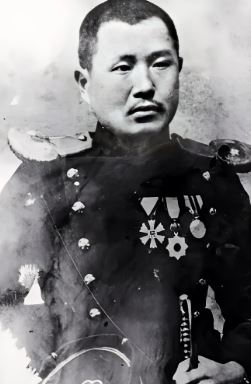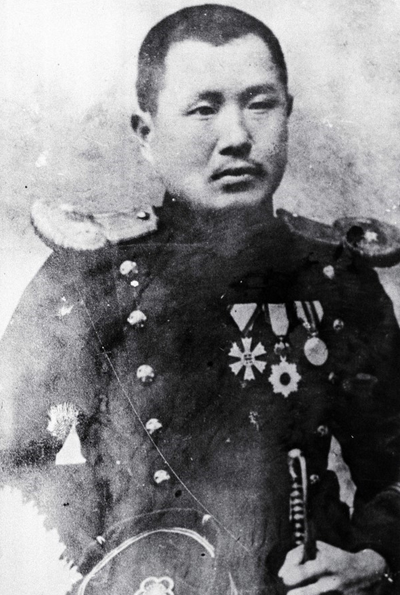Gye-won No Baek-rin was born in Punghae-myeon, Songhwa-gun, Hwanghae Province. From a young age, he was praised as a potential general due to his tall stature and exceptional strength. While learning classical Chinese in his hometown, he moved to Seoul and in 1895 was selected as one of 120 outstanding students nationwide by the government to study in Japan as a government-sponsored student. He graduated from Gyeong-eung Institute along with Lee Gap, Yoo Dong-yeol, and Yoon Chi-seong in Japan.
That year, political upheavals such as the Eulmi Incident and the Gwangmu Restoration occurred, and when pro-Japanese figure Park Yeong-hyo fled to Japan, the government falsely accused the students of being involved in the conspiracy and stopped sending them tuition funds. However, No Baek-rin, determined to continue his studies, graduated from the Hapseong School in 1898. The following November, he graduated with excellent marks from the Imperial Japanese Army Academy. He returned to Korea in 1900 and, through the active mediation of Min Yeong-hwan, was commissioned as a military officer along with Yoon Chi-seong, dedicating himself to training future military leaders as an instructor at the Korean Military Academy. During the Russo-Japanese War in 1904, he served as an observer and inspected regions such as Manchuria, holding key military positions such as the head of the Army Military Academy and the head of the Army Training School, working hard to develop the national military.
On August 1, 1907, when the Korean army was disbanded in a humiliating defeat, he left the military and entered the education sector, becoming the principal of Boseong School. He was also involved in various businesses, including leather goods, grocery stores, gold mines, and ironworks, striving to promote national industry to combat economic invasion, which was as dangerous as military invasion. While lamenting the loss of national sovereignty, he organized the Shinmin Society with figures like Ahn Chang-ho, Lee Gap, and Shin Chae-ho to develop a national salvation movement and established Gwangmu Academy in his hometown of Songhwa.
In 1908, he organized the Education Association with Kim Gu and others, and in 1910, he fled to the United States. In June of that year, he founded the National Army Corps in Hawaii with Park Yong-man and trained over 300 independence fighters. When the Provisional Government of the Republic of Korea was established in 1919, he engaged in anti-Japanese independence activities through it. As a former military officer, he believed that independence could be achieved through armed struggle.
He was appointed as the second Minister of Military Affairs in the Provisional Government, succeeding Lee Dong-hwi, and was selected as a representative for the Paris Peace Conference alongside Lee Seung-man, Ahn Chang-ho, Park Yong-man, Lee Dong-hwi, and Kim Kyu-sik. He believed that future battles would be won by those who dominate the skies, and on February 20, 1920, he established the first flight training school for Koreans near Willows, Sacramento, to train pilots, supported financially by the wealthy Kim Jong-rim.
In January 1920, he issued the first proclamation from the Ministry of Military Affairs urging all citizens to join the ranks of the Korean Liberation Army, dedicating himself to supporting the army’s combat efforts while residing in the U.S.
In July 1921, he left Willows and returned to Shanghai. At that time, the Provisional Government was divided into four groups due to differences in the independence movement’s direction during the unification process: the Korean National Assembly Government led by Moon Chang-beom, the Military Unification Association in Beijing led by Park Yong-man and Shin Chae-ho, the Korean Socialist Party led by Lee Dong-hwi, and the faction supporting the Provisional Government led by Ahn Chang-ho. The departure of Lee Seung-man, Kim Kyu-sik, and No Baek-rin from the U.S. to Shanghai aimed to resolve these factional disputes.
In June 1922, he was appointed Prime Minister by Provisional Government President Lee Seung-man and led the Provisional Government until April 1924. A brave soldier and an independent activist with integrity and passion, he passed away on January 22, 1925, in Shanghai at the age of 52. He wore the Korean military uniform until his death, maintaining his pride as a Korean soldier. His grave was initially placed in the Shanghai International Cemetery and was moved to Korea during the repatriation of remains of Provisional Government officials in 1993. On March 1, 1962, he was posthumously awarded the Order of National Foundation for his contributions to the nation.


Leave a Reply